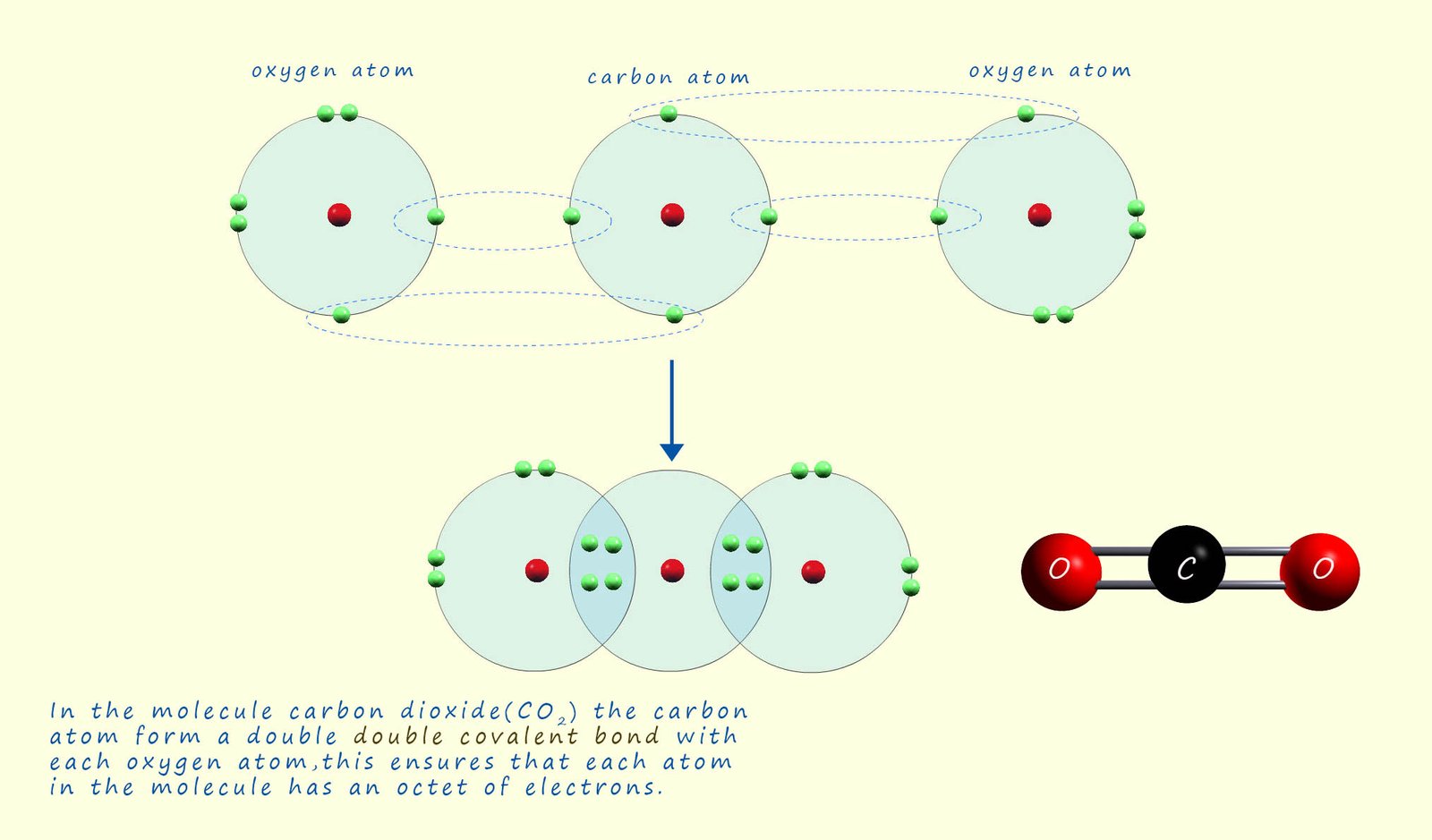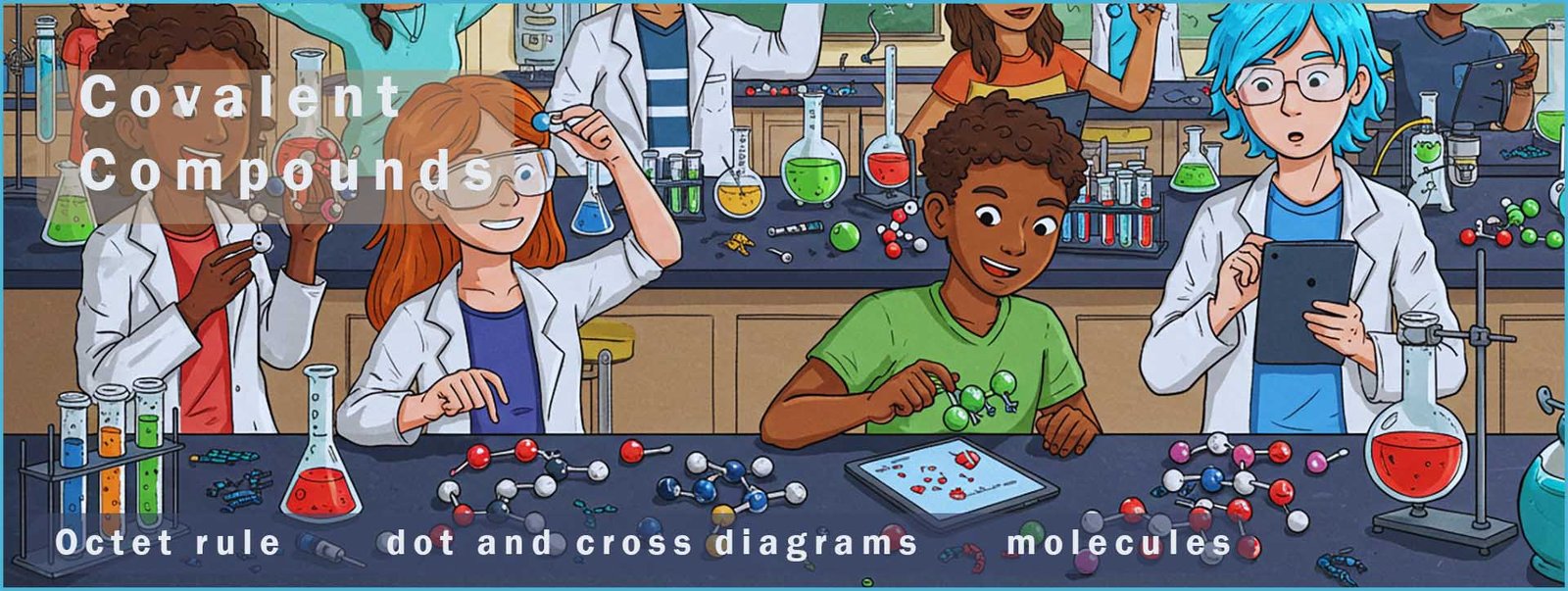

Higher and foundation tiers
Covalent bonding involves the sharing of a pair of
electrons between non-metal atoms. Most covalent substances have small molecular structures, though group 4 non-metal elements such as carbon and silicon can form giant or macromolecular structures which have a giant structure in which the atoms all form covalent bonds.
The two atoms
involved in a forming a covalent bond are held together by the electrostatic force of attraction between the
positively charged nuclei
and the negatively charged shared pair of electrons, this is shown in the diagram below. Here two hydrogen atoms have joined together to form a hydrogen molecule.

A hydrogen atom has only one electron in its outer electron shell, this electron shell can of course hold a maximum of 2 electrons and to achieve a full outer electron shell the two hydrogen atoms simply combine to form a hydrogen molecule, this will involve each hydrogen atom sharing their electrons. This sharing of a pair of electrons is called a covalent bond. If you study the diagram above carefully you will see that the two negatively charged electrons are held in place or are attracted to the two positively charged nuclei in the hydrogen molecule. There is of course repulsive forces between the two positively charged nuclei in the hydrogen molecule, however as long as the attractive forces between the two nuclei and the electrons are stronger than the repulsive forces then the covalent bond will be stable.
Recall that a simple rule called the octet rule is used to help predict how atoms will react with each other and the number of bonds they will form. This simple rule states that atoms will react in such a way that they end up with full outer electron shells, this usually means 8 electrons in their outer or valence electron shell, that is the same outer electron arrangement as a noble gas in group 0 in the periodic table.
The octet rule states that atoms will only react to form compounds if they can achieve eight electrons in their outer or valence electron shell.
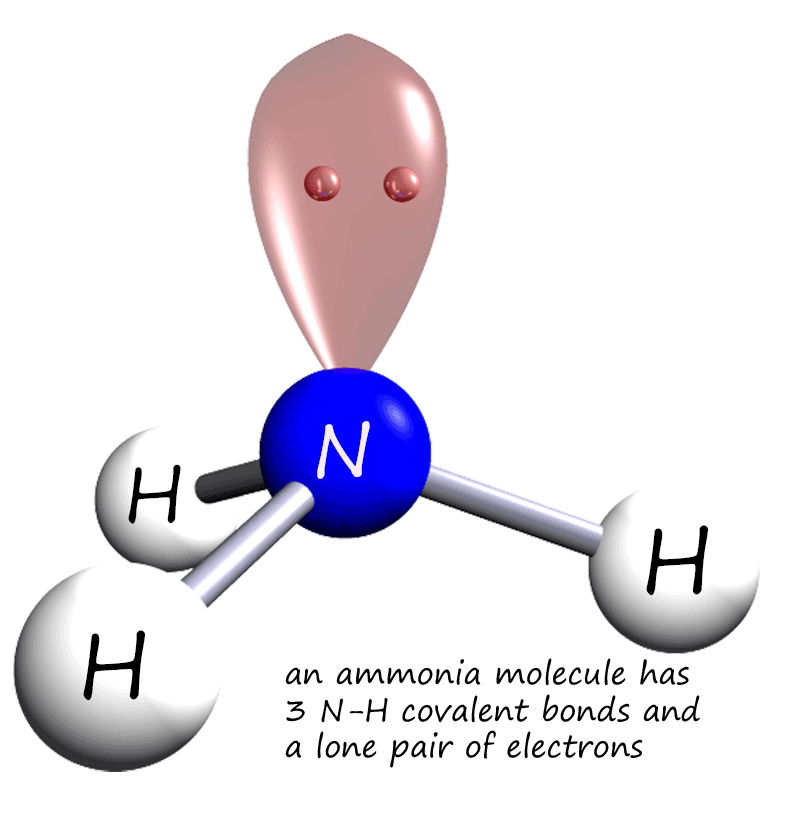
The non-metals elements, which form covalent bonds are found in the right hand side of the periodic table and the reactive non-metals elements are mostly found in groups 5, 6 and 7 in the periodic table. The non-metals elements found in these groups will have almost full outer electron shells, so when these non-metal elements react they will be looking to gain electrons in order to achieve a stable octet of electrons, that is 8 electrons in their outer or valency shell, or 2 electrons in the case of elements such as hydrogen which only have an electron in the first electron shell.
Now most covalent substances consist of small molecules and are often described as having a molecular structure. As an example of a covalent molecule consider ammonia, now ammonia is a small molecule made up of only 4 atoms as shown in the image opposite; one atom of nitrogen and 3 atoms of hydrogen. Its chemical formula is NH3. We can easily draw a dot and cross diagram to show how the covalent bonds in molecules such as ammonia are formed.
Ammonia is a small covalent molecule with the formula NH3. The ammonia molecule has 3N-H covalent bonds and a lone pair or non-bonding pair of electrons. The image opposite shows an ammonia molecule with its lone pair of electrons.
Below is a dot and cross diagram to show how each of the covalent bonds in an ammonia molecule is formed. A nitrogen atom has an electron arrangement 2,5 and a hydrogen atom is also shown with its one outer shell electron; shown as a black cross (X) in the diagram below. While the 5 electrons in the nitrogen atom's valency shell are shown as green dots. In a dot and cross diagram we usually only show the outer shell electrons.
In order to achieve full outer electron shells both these non-metal atoms need to share electrons, that is they will form covalent bonds in order to achieve full outer electron shells. The electrons are shared in pairs and a pair of shared electrons results in the formation of a covalent bond between the two atoms. Now the nitrogen atom needs to gain 3 electrons to fill its outer electron shell so it will form 3 covalent bonds. Hydrogen only needs to gain 1 electron to fill its outer electron shell so each hydrogen atom will only form 1 covalent bond. This is outlined in the diagram below:

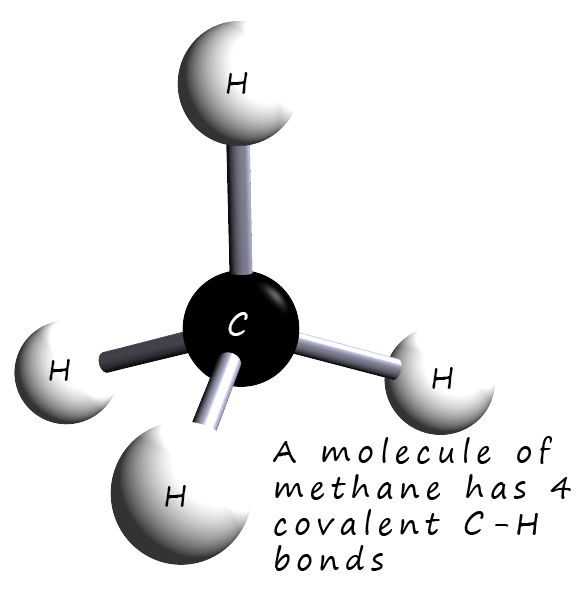
As a second example of a dot and cross diagram consider the molecule methane (CH4). Now methane is the gas used to heat our homes and for cooking with it, is also the gas used in Bunsen burners in the science lab. Its chemical formula is CH4. Methane is a covalent compound consisting of 1 atom of carbon and 4 atoms of hydrogen. Carbon is found in group 4 of the periodic table and has an electron arrangement of 2,4. So each carbon atom needs to gain 4 electrons to completely fill its outer electron shell; this means it will form 4 covalent bonds. In the dot and cross diagram below you can clearly see that each carbon atom bonds with 4 hydrogen atoms in order to achieve a full outer electron shell or a stable octet of electrons.
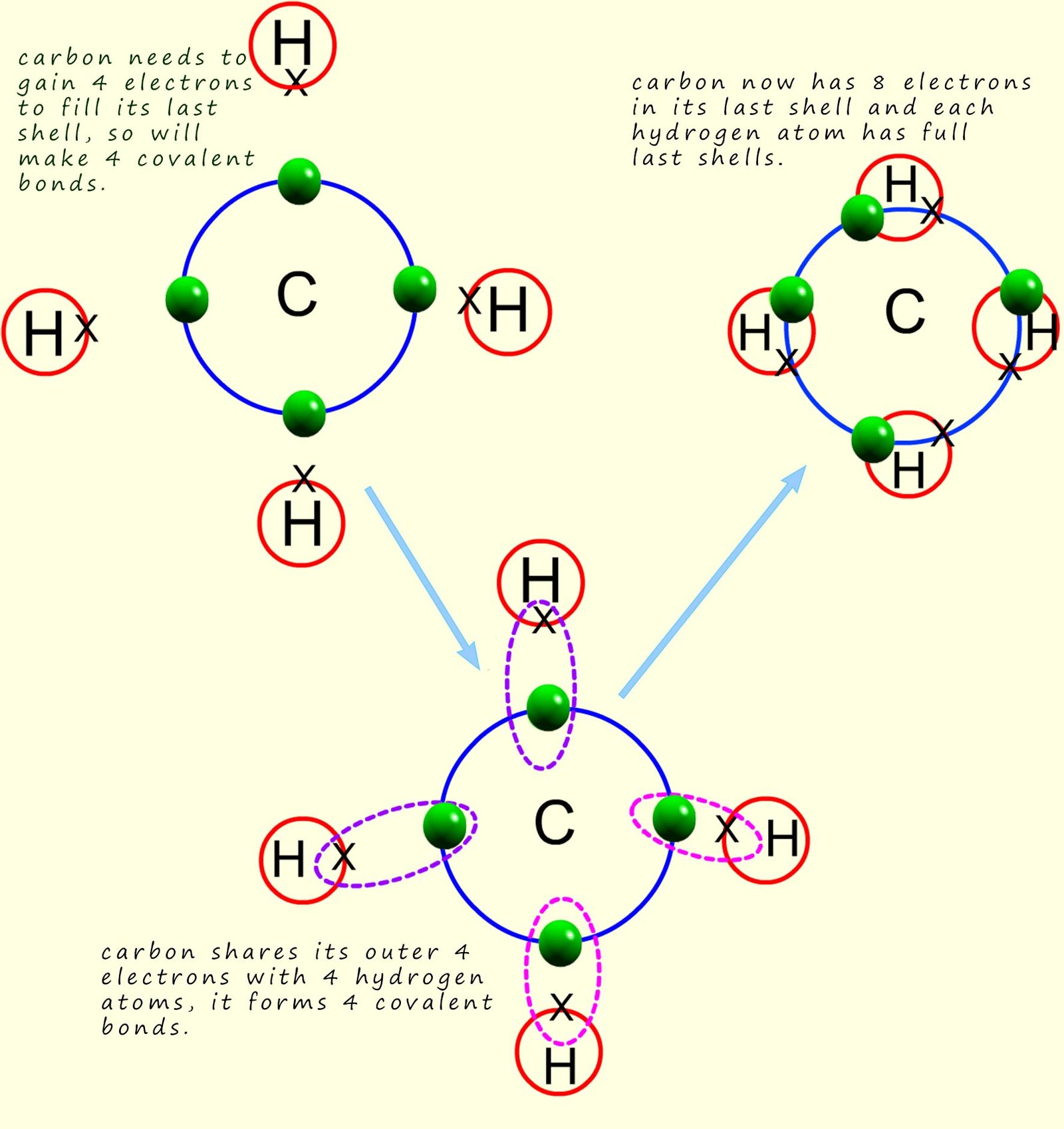
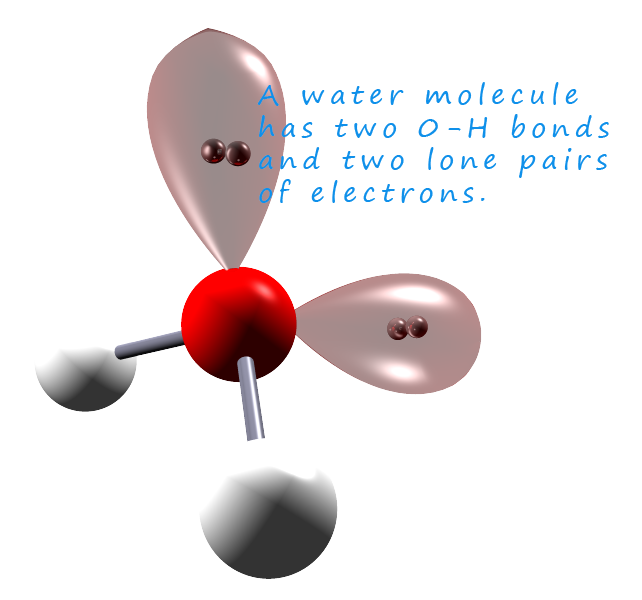
As a third example of a dot and cross diagram consider the water molecule (H2O). This obviously contains one atom of oxygen covalently bonded to two atoms of hydrogen. Now oxygen is a group 6 non-metal with an
electron arrangement of 2,6. So it needs to gain 2 electrons to obtain
a full outer shell of electrons and as before each
hydrogen only needs to gain one electron to fill its last shell.
To gain 2 electrons each oxygen atom
will make 2
covalent bonds,
while each hydrogen atom only needs to gain 1 electron; so it will make one
covalent bond.
This will ensure that all the atoms in the water molecule will end up with a full outer shell of
electrons. The oxygen atom also
has 4 electrons in its last shell which are not used in bonding;
these will form the 2 lone pairs or non-bonding pairs of electrons
as shown in the image opposite.
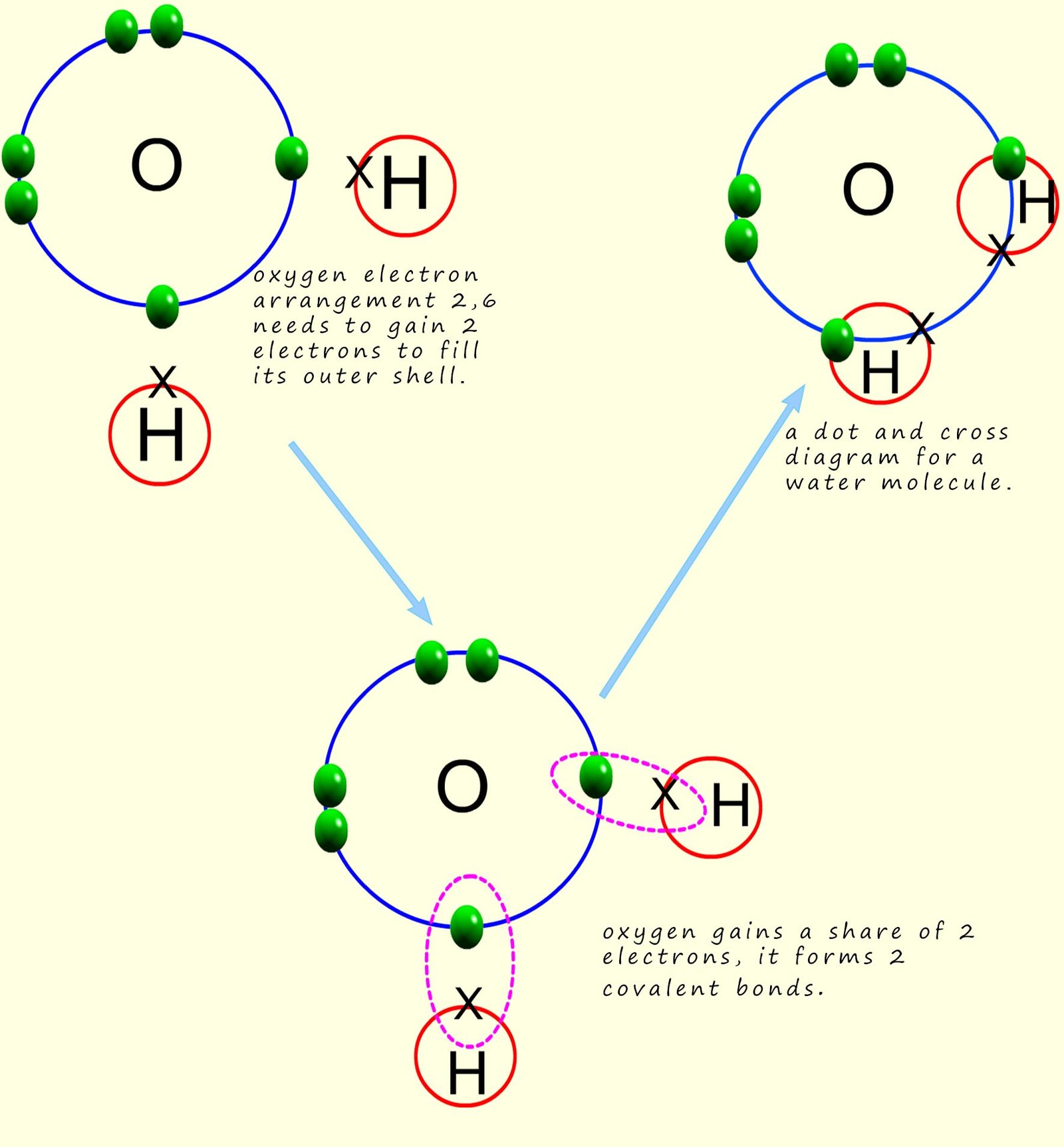
If the atoms present in a molecule share only 2 electrons then they will form single covalent bond between them. However if the atoms have to share more than 2 electrons in order to achieve full outer electron shells then double or even triple covalent bonds will be formed e.g. study the dot and cross diagrams below for three diatomic molecules hydrogen (H2), oxygen (O2) and nitrogen (N2). Recall that oxygen atoms have 6 electrons in their outer electron shell so they will need to gain two electrons in order to achieve an octet of electrons in their outer electron shell and so when oxygen atoms join to form an oxygen molecule these molecules will contain double covalent bonds between the atoms. Nitrogen atoms having only 5 electrons in their outer electron shells need to gain 3 more electrons to complete the outer electron shell, so when nitrogen atoms join to form a nitrogen molecule there will be six electrons in the area of overlap between the two atoms, this means that there is a triple covalent bond between the atoms. The image below explains this in more detail:
Hydrogen atoms contain only one electron and when two hydrogen atoms combine to form a hydrogen molecule they share 2 electrons and the molecule contains a single covalent bond as shown below:

Oxygen atoms have 6 electrons in their outer valency shell and so need to gain a further 2 electrons to achieve a stable octet of electrons. This means that when 2 oxygen atoms combine to form an oxygen molecule this molecule will contain a double covalent bond, that is the oxygen atoms share 4 electrons as outlined below:
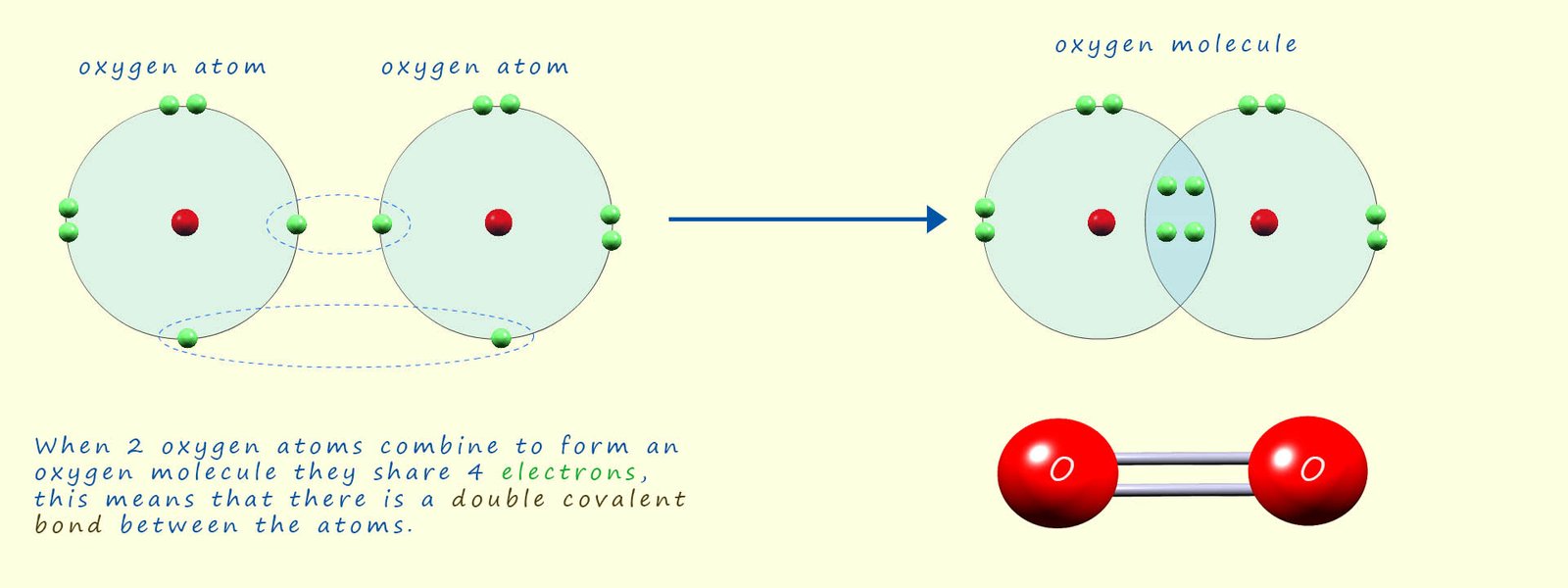
Nitrogen being a group 5 element has 5 electrons in its outer electron shell. This means that it needs to gain 3 electrons to form a stable octet of electrons, so nitrogen atoms when they combine to form a nitrogen molecule will share 6 electrons and form a triple covalent bond. This is the main reason why nitrogen is such an unreactive gas; it takes a large amount of energy to break this triple covalent bond.
There is also one lone pair of electrons on each nitrogen atom in the nitrogen molecule.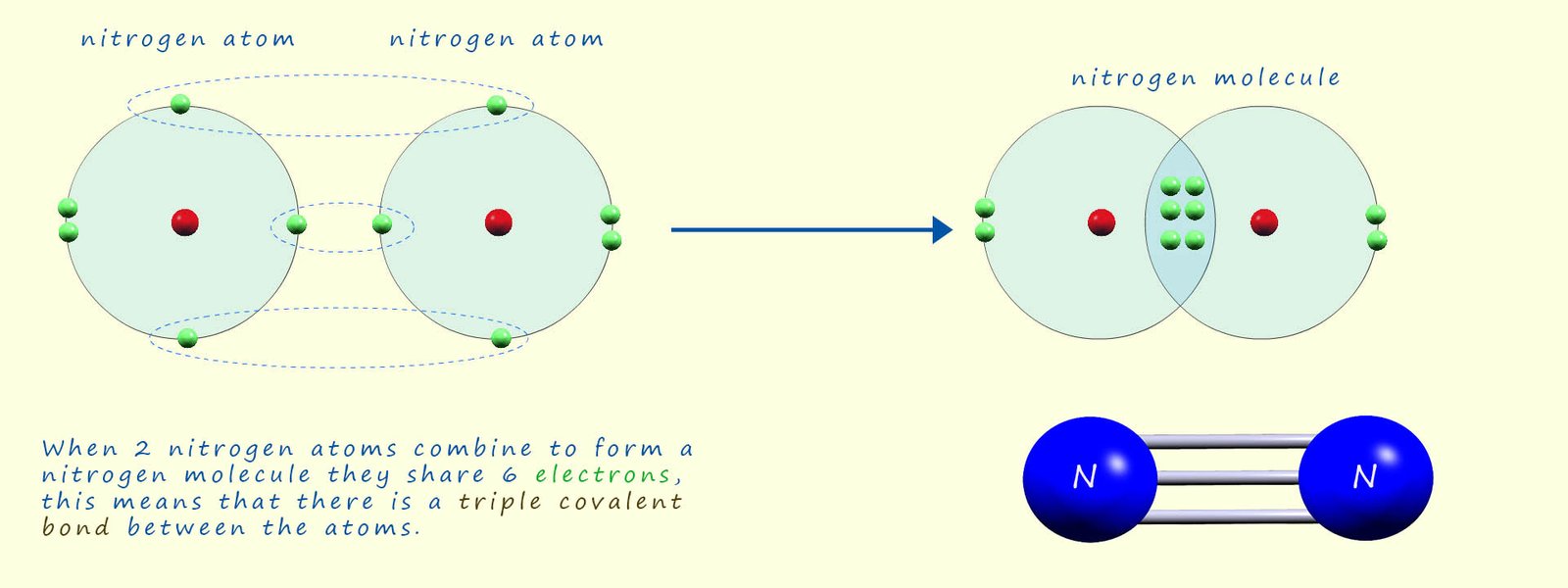
Carbon dioxide (CO2) is small covalent molecule that
contains a double
covalent bond between the atoms of carbon and
oxygen. Carbon has an electron
arrangement of 2, 4 and so it needs to gain a further 4 electrons
to complete its octet of electrons. Oxygen has an
electron
arrangement 2, 6 so needs to gain 2 electrons to fill its outer electron shell.
In order for both the carbon and oxygen atoms to end up with
full last shells they share 4 electrons between them. This results
in a double C=O covalent bond forming. The diagram below
outlines how the carbon dioxide molecule forms:
